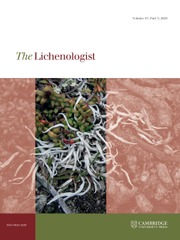Article contents
An updated world key to the species of Acanthothecis s. lat. (Ascomycota: Graphidaceae), with ten new species from Brazil
Published online by Cambridge University Press: 31 March 2022
Abstract
As part of a revision of the genus Acanthothecis s. lat. (Graphidaceae) in Brazil, an updated world key to the known species of the genus is presented. From Brazil, the following ten new species are described: A. latispora, with single-spored asci, large, muriform ascospores, and norstictic and stictic acids; A. megalospora, with single-spored asci, very large, transversely septate ascospores, and norstictic and protocetraric acids; A. multiseptata, with 8-spored asci, medium-sized and narrow, transversely multiseptate ascospores, and lacking secondary substances except terpenoids; A. norstictica, with 1–2-spored asci, large, muriform ascospores, and norstictic acid; A. oryzoides, with 8-spored asci, medium-sized, transversely septate ascospores, and norstictic acid; A. rimosa, with 2-spored asci, small to medium-sized, muriform ascospores, and stictic acid; A. roseola, with 1–2-spored asci, large, muriform ascospores, and norstictic, stictic and subnorstictic acids; A. saxicola, with 8-spored asci, small, 3-septate ascospores, and norstictic acid; A. subfarinosa, with 8-spored asci, small, 6–8-septate ascospores, and norstictic acid; and A. submuriformis, with 8-spored asci, small, submuriform ascospores, and lichexanthone. In addition, three further species are formally validated, namely A. bicellulata, A. farinosa and A. subabaphoides, and the new combination A. bicellularis is proposed, based on Acanthotrema bicellularis.
- Type
- Standard Paper
- Information
- Copyright
- Copyright © The Author(s), 2022. Published by Cambridge University Press on behalf of the British Lichen Society
References
- 2
- Cited by





